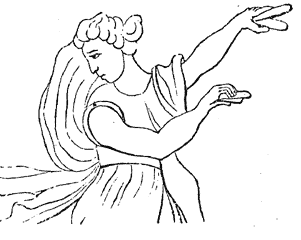
Crotalum
Encyclopedia

Classical antiquity
Classical antiquity is a broad term for a long period of cultural history centered on the Mediterranean Sea, comprising the interlocking civilizations of ancient Greece and ancient Rome, collectively known as the Greco-Roman world...
, a crotalum was a kind of clapper
Clapper
A clapper may refer to one of the following:*Part of a bell*Clapper bridge*A sound-activated gadget called The Clapper*A character from the video game Donkey Kong Country 2: Diddy's Kong Quest*Clapboard used in film production...
or castanet
Castanet
Castanets are a percussion instrument , used in Moorish, Ottoman, ancient Roman, Italian, Spanish, Sephardic Music, and Portuguese music. The instrument consists of a pair of concave shells joined on one edge by a string. They are held in the hand and used to produce clicks for rhythmic accents or...
used in religious dances by groups in ancient Greece
Ancient Greece
Ancient Greece is a civilization belonging to a period of Greek history that lasted from the Archaic period of the 8th to 6th centuries BC to the end of antiquity. Immediately following this period was the beginning of the Early Middle Ages and the Byzantine era. Included in Ancient Greece is the...
and elsewhere, including the Korybantes
Korybantes
The Corybantes were the armed and crested dancers who worshipped the Phrygian goddess Cybele with drumming and dancing. They are also called the Kurbantes in Phrygia, and Corybants in an older English transcription. The Kuretes were the nine dancers who venerate Rhea, the Cretan counterpart of...
.
The term has been erroneously supposed by some writers to be the same with the sistrum
Sistrum
A sistrum is a musical instrument of the percussion family, chiefly associated with ancient Iraq and Egypt. It consists of a handle and a U-shaped metal frame, made of brass or bronze and between 76 and 30 cm in width...
. These mistakes are refuted at length by Friedrich Adolph Lampe (1683-1729) in De cymbalis veterum. From the Suda
Suda
The Suda or Souda is a massive 10th century Byzantine encyclopedia of the ancient Mediterranean world, formerly attributed to an author called Suidas. It is an encyclopedic lexicon, written in Greek, with 30,000 entries, many drawing from ancient sources that have since been lost, and often...
and the Scholiast on Aristophanes
Aristophanes
Aristophanes , son of Philippus, of the deme Cydathenaus, was a comic playwright of ancient Athens. Eleven of his forty plays survive virtually complete...
(Nubes, 260), it appears to have been a split reed or cane, which clattered when shaken with the hand. According to Eustathius
Eustathius of Thessalonica
Archbishop Eustathius of Thessalonica was a Greek bishop and scholar. He is most noted for his contemporary account of the sack of Thessalonike by the Normans in 1185, for his orations and for his commentaries on Homer, which incorporate many remarks by much earlier researchers.- Life :After being...
(Il. XI.160), it was made of shell and brass, as well as wood. Clement of Alexandria
Clement of Alexandria
Titus Flavius Clemens , known as Clement of Alexandria , was a Christian theologian and the head of the noted Catechetical School of Alexandria. Clement is best remembered as the teacher of Origen...
attributes the instruments invention to the Sicilians, and forbids the use thereof to the Christians, because of the motions and gestures accompanying the practice.
Women who played on the crotalum were termed crotalistriae. Such was Virgil's Copa (2),
- "Crispum sub crotalo docta movere latus."
This line alludes to the dance with crotala (similar to castanets), for which we have the additional testimony of Macrobius (Saturnalia III.14.4‑8).
As the instrument made a noise somewhat like that of a crane
Crane (bird)
Cranes are a family, Gruidae, of large, long-legged and long-necked birds in the order Gruiformes. There are fifteen species of crane in four genera. Unlike the similar-looking but unrelated herons, cranes fly with necks outstretched, not pulled back...
's bill, the bird was called crotalistria, "player on crotala".
Pausanias
Pausanias (geographer)
Pausanias was a Greek traveler and geographer of the 2nd century AD, who lived in the times of Hadrian, Antoninus Pius and Marcus Aurelius. He is famous for his Description of Greece , a lengthy work that describes ancient Greece from firsthand observations, and is a crucial link between classical...
affirms by way of the epic poet Pisander of Camirus that Heracles
Heracles
Heracles ,born Alcaeus or Alcides , was a divine hero in Greek mythology, the son of Zeus and Alcmene, foster son of Amphitryon and great-grandson of Perseus...
did not kill the birds
Stymphalian birds
In Greek mythology, the Stymphalian birds were man-eating birds with beaks of bronze and sharp metallic feathers they could launch at their victims, and were sacred to Ares, the god of war. Furthermore, their dung was highly toxic...
of Lake Stymphalia
Lake Stymphalia
Lake Stymphalia is located in the north-eastern part of the Peloponnese, in the Corinthia prefecture. It is a Wetlands area, a popular farming area. Usually this area around the lake is fairly dry underfoot. In certain weather conditions thousands of small green frogs hide in the damp grass from...
, but that he drove them away by playing on crotala. Based on this, the instrument must be exceedingly ancient.
The word (krotalos) is often applied, by an easy metaphor, to a noisy talkative person (Aristoph. Nub. 448; Eurip. Cycl. 104). Though it might be a false cognate, it is interesting to note that one of the Spanish names for "rattlesnake" is crótalo.

